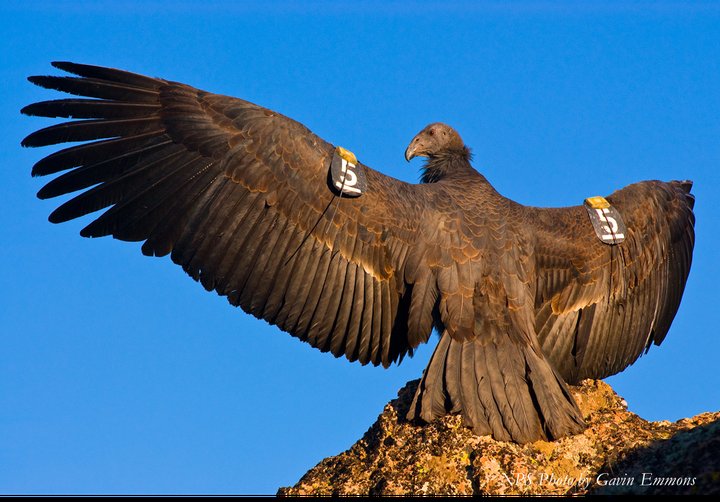
Photo: Gavin Emmons, via the National Parks Service.
Press release from the U.S. Fish and Wildlife Service:
Sacramento, CA.— The majestic California condor once soared the skies over western North America from British Columbia to Mexico. However, by 1985, the condor had spiraled down to the brink of extinction, with only 22 birds remaining. These remaining birds were taken into captivity in a last ditch effort to save the species. That effort paid off. Today, thanks to three decades of dedicated work by a range of partners, 290 condors now fly free in the wild, all in the Desert Southwest and northern Baja Peninsula. Now, the U.S. Fish and Wildlife Service, the Yurok Tribe of Northern California and National Park Service are taking the next big step in the condor’s recovery with a proposal to reintroduce America’s largest land bird to parts of the Pacific Northwest, where it has not been seen for over a century.
Building on a decade’s worth of preparation initiated by the Yurok Tribe, the U.S. Fish and Wildlife Service is proposing to establish a collaboratively managed new California condor release facility in Redwood National Park, within the Tribe’s ancestral territory. Like the southwestern population, this new population would be given the special status of “Nonessential, Experimental” under the Endangered Species Act, which would provide protections to the released birds while also allowing flexibility to landowners and other stakeholders potentially affected by the reintroduction of this federally listed endangered species.
“For ten years, we have been laying the groundwork to bring the condor back to Yurok Country,” said Joseph L. James, Chairman of the Yurok Tribe. “I am excited about the prospect of seeing the sacred prey-go-neesh soaring over Yurok skies. The Yurok Tribe is sincerely grateful for the U.S. Fish and Wildlife Service’s and Redwood National Park’s recent partnership in this effort to fill a crucial ecological niche and restore balance in our world.”
“This is an exciting time in the Condor’s history. After more than a hundred-year absence, this magnificent bird could once again fly high above the Pacific Northwest,” said Amedee Brickey, U.S. Fish and Wildlife Service California condor coordinator. “The successful reintroductions in southern California, Arizona and Mexico have taught us a great deal, and while challenges remain, we believe we have a model for success with these northern reintroductions.”
“This reintroduction is another chapter in the story of hope and perseverance that exemplifies condor recovery,” said Steve Mietz, Superintendent of Redwood National Park. “The Yurok Tribe, U.S. Fish and Wildlife Service, and National Park Service have built a broad coalition of support for condor recovery which will serve as a model for collaborative restoration of a wide ranging species.”
With a wingspan of almost 10 feet, the California condor is the biggest soaring land bird on the North American continent. It is a scavenger, feeding on dead animals—nature’s original recycler. Native people throughout their historical range revere them, and the Yurok people have incorporated fallen condor feathers into sacred ceremonial practices since time immemorial.
The foundation of the successful condor reintroduction program in the Southwest has been strong, diverse and durable partnerships. Similar partnerships will be pivotal in the northwestern reintroductions. The U.S. Fish and Wildlife Service, Yurok Tribe and the National Park Service are among 16 partners teaming up in this effort, including California Fish and Wildlife and local community groups.
The science behind the return of the California condor to its native range in the Pacific Northwest is strong. The reintroduction sites provide prime condor habitat, with redwood forests and mountain ranges that can provide ample roosting and nest habitat. Inland valleys and mountain top prairies, along with coastline will provide a mixture of land and marine food areas and food resources.
The two Department of the Interior bureaus and the Tribe are also announcing the availability of a joint Environmental Assessment that analyzes the potential environmental impacts associated with the proposed reintroduction and designation of a nonessential experimental population. The partners will host public meetings in northern California and Oregon to provide information and receive input on the proposal and the environmental assessment in May 2019. The schedule is available online at https://parkplanning.nps.gov/meetingNotices.cfm?projectID=66364.
The proposal for establishing a Northwest condor population will publish in the Federal Register on April 5, 2019, opening a 60-day public comment period. The Service will consider comments from all interested parties received by June 4, 2019. Information on how to submit comments is available at www.regulations.gov by searching under docket number FWS–R1–ES–2018-033.
To learn more about the reintroduction effort and to view and comment on the Environmental Assessment associated with this action visit: https://parkplanning.nps.gov/projectHome.cfm?projectID=66364
The Yurok Tribe, California’s largest federally recognized tribe, exercises its inherent sovereignty in order to conserve, protect and restore Yurok natural resources and culture and the health and social well-being of existing and future Tribal members through its exercise of sovereign rights, culturally integrated methods, and high quality scientific practices in coordination with the community, public agencies, and private organizations. For more information about our work, visit http://www.yuroktribe.org/ or connect with us via Facebook. The U.S. Fish and Wildlife Service works with others to conserve, protect, and enhance fish, wildlife, plants, and their habitats for the continuing benefit of the American people. For more information about our work and the people who make it happen, visit https://www.fws.gov/cno/ or connect with us via Facebook, Twitter, YouTube, and Flickr.
# # #
PREVIOUSLY: They’re Planning to Bring the California Condor Back to Humboldt! Your Input Welcomed at Meetings Next Week
CLICK TO MANAGE